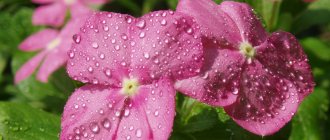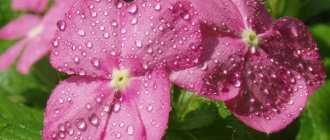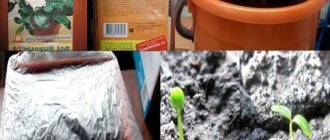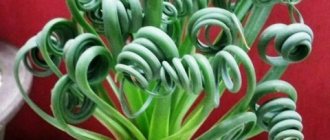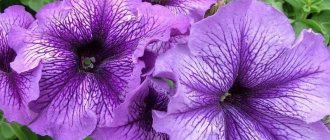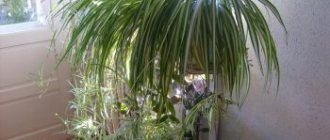Proper pruning. We form a lush balsam bush.
The leading engineer of the gardening department of the Krasnoyarsk flora and fauna park “Roev Ruchey” shared with us her secrets on how to get lush, beautiful balsam bushes.
In the summer, a large number of balsams bloom in the park. In the conditions of Eastern Siberia, this plant is successfully grown as an annual and does not overwinter in open ground. In order not to sow a large number of plants every year, the gardening department leaves the strongest balsam bushes every autumn and uses them as queen cells, that is, donors of cuttings for future plants.
In order to get a powerful, strong bush that will look great and bloom profusely, you need to spare no balsam when pruning. All the resulting shoots will not be lost; they can be rooted.
Before you start, make sure that the plant is not sick and receives enough fertilizer. Before pruning, you may need to increase the amount of fertilizer you apply or fertilize more often.
Here, for example, is what the schedule for fertilizing with organic fertilizer looks like for February-March in the gardening department. During these months, cuttings are actively taken so that the young plants are ready for the season.
Trim the long shoot an inch above the lowest node.
From this node, several new shoots will subsequently develop.
To avoid rotting and other unpleasant consequences, the cut must be clean, even and at an angle of 45 degrees.
A utility knife is best for cutting.
This is the kind of “stump” you should get in the end.
Without regret, we do this with all single (non-branching) long shoots.
After finishing the pruning, we ended up with a “trimmed” plant that will actively grow and form a lush, regular bush.
Trimmed shoots will not be lost. We take cuttings and root them to produce new balsams.
We will talk about the correct cuttings of balsam and petunias in the following articles, so give a thumbs up and subscribe to this channel so you don’t miss anything.
Also, run into the contact group of the gardening department, who shared their secrets with us:
Source
Peculiarities
Impatiens belong to the family of annual and perennial herbaceous plants, and are sometimes subshrubs. They cannot be called unpretentious when growing seedlings, since there are certain rules to obtain a good result. If you follow them, then balsams will be able to please even a novice gardener with flowering.
There are many varieties of balsam. They are grown both indoors and as garden plants. The timing of planting and care features largely depend on the variety: fertilization, loosening, watering. At home, seedlings need to create a comfortable environment to prepare for planting them in open ground. Impatiens can have serrated or rounded leaves in a variety of green shades. The fruit is a multi-seeded capsule. If you touch it, it opens easily and the seeds fall out.
The color range of balsams is very diverse. White, pink and red specimens are popular. Flower petals can be smooth, semi-double or double. Flowering occurs unharmoniously. Often, at the same time as withered flowers, you can see forming buds or blooming flowers.
Rules for caring for garden balsam seedlings
To grow good and healthy balsam seedlings at home, you need to properly care for them and maintain optimal conditions. Let's look at all the rules and features in more detail.
Care scheme after sowing and before emergence:
- Seeds germinate in light, so you need to immediately place the container in a bright place.
- The temperature is maintained around 22-25 degrees Celsius.
- The greenhouse needs to be ventilated every day for 15 minutes - morning and evening. Condensation must be removed from the lid or film.
- Seeds should always be kept in moist soil, otherwise, when they dry out, the swollen seeds will lose their viability and will not germinate. Therefore, watering must be done regularly, preventing the soil surface from drying out. But there is no need to overfill either. Moisturize using a spray bottle so that the water can be distributed as evenly as possible.
- When the first shoots appear, you need to open the greenhouse gradually - first for an hour, then increase the time every day - on the second day by 3-4 hours, on the third - by 5-6 hours, on the fourth day the lid or film is completely removed.
Rules for caring for balsam seedlings at home after germination:
Now watering needs to be done at the root so that water does not fall on the seedlings, it is advisable to do this along the edge of the container. It is very convenient to water plants using a regular syringe or a small syringe. It should be moistened as the top layer dries, but underneath the top layer the soil should always be slightly moist.
- Immediately after the first loops appear, the temperature of the balsam seedlings decreases; now it is necessary to maintain +18°C during the day and +16°C at night.
- At this stage of growing, seedlings need good lighting even more. The length of daylight required for normal growth and development is at least 12-14 hours, for this reason it is necessary to supplement the plants with phytolamps or at least LED lamps.
What to do if balsam seedlings have stretched out
Seedlings can stretch out for three reasons: sowing too early, elevated temperatures, and lack of lighting. Pulling can be very easily prevented if you plant on time, provide additional light to the plants and provide optimal temperature conditions.
But what to do if the balsam seedlings have already stretched out?
- If you just started to stretch out, then you need to change the conditions - put it in a cooler place and be sure to use phytolamps in the morning, evening and in cloudy weather.
- If it has stretched out too much, then it is better to transplant it into separate pots before the stem falls under the weight of the leaves. Read below about how to transplant.
Further care in open ground
Caring for garden balsam is not difficult, you just need to follow the described steps in time:
| LIGHTING, TEMPERATURE CONDITION | As soon as the air temperature drops a little, you need to move the flower to a warm place. He endures sudden changes painfully. Plant growth also occurs in winter at not too low temperatures (more than 11-13 ° C). At this time, for the bush to actively grow, it needs lighting. |
| FERTILIZERS | It is very important to regularly feed balsam with various fertilizers, otherwise flowering may not be as active as we would like. But the same result can be achieved by applying fertilizer in excess. Therefore, you need to adhere to the norm, fertilizing the plant once every two weeks until October. |
| WATERING | If it is warm outside, you need to water the flower regularly. In winter, water as needed - when the soil begins to dry out. The water should be settled and at room temperature. |
| TRIM | For more abundant and long-lasting flowering, remove faded inflorescences. |
Balsam tom tumb
Impatiens (impatiens) is an annual herbaceous plant reaching a stem height of 20-75 cm. The popular name is impatiens impatiens, named because of its sensitivity to touch. The homeland is China, India, Central Asia, but the flower is perfectly adapted to growing in temperate latitudes.
For a plant such as garden balsam, planting and care is a very undemanding task. Without much effort, it can be grown in a flower bed, balcony, windowsill, small and large pots. Flowering lasts from the end of May until the start of frost.
Often bicolor, the flowers are simple and double, in inflorescences and single (purple, red, white).
Varieties of garden balsam
In total there are approximately 500 types of balsam. Garden varieties of different colors were developed:
- Impatiens tom samb violet is an annual plant no lower than 20 cm. It grows quite quickly and blooms densely with purple double flowers. Loves warmth, but easily tolerates slight shading. Flowering occurs from early summer to early autumn;
- Impatiens tom samb bicolor is an annual bush, reaching a height of 20 cm or more. The flowers are beautiful, double, and have a white and red color. Planting seeds begins in March-April. Blooms all summer until September. Suitable for growing indoors and outdoors;
- Impatiens tom samb white is a flower that is perfect for semi-shaded places. Grows up to 15-20 cm. The flowers are white, with dense foliage. Sown in March, it begins to bloom profusely in June. Flowering continues until the end of September;
- balsam tom samb salmon is a small annual with dense foliage, reaching 25 cm in height. Feels good near places with insufficient lighting. Has double pinkish flowers. Grow in flower beds and window sills;
- Impatiens tom samb pink is a plant reaching a height of 40 cm. It has dense foliage and exquisite pink flowers. Flowering is abundant and lasts all summer until the first frost. Prefers light, fertilized soil;
- balsam tom samb scarlet is a shade-tolerant plant, reaching a maximum height of 40 cm. Double flowers are bright red. Ideal for growing in flower beds, greenhouses, window sills;
- exotic dwarf balsam is a very low bush no more than 18 cm high. Mainly suitable for growing indoors (window sills, balconies). A very undemanding plant that blooms profusely even in low light conditions. Dwarf impatiens have bright pink, orange, purple, and white flowers. Pleases with its appearance until the first frost;
- balsam tom tumb - has fairly large double flowers, 7 cm in diameter, reaching 45 cm in height. The flowers have a variety of colors (pink, lilac, white). It begins to bloom from the end of May - June, before the beginning of autumn frosts.
- Balsam boy the size of a finger is an annual early flowering plant, no more than 25 cm high. Decorated with massive flowers of various colors. Suitable for growing in flower beds, window sills, and flowerpots. Loves fertilized, moist, not soggy soil.
Popular articles Growing mini-violets at home
Balsam: history, types, care
Planting and caring for balsam seeds
Growing from seeds is the easiest way to get this beautiful flower in your flowerbed. Sowing balsam seeds occurs in several stages:
- First you need to prepare the soil for sowing. The soil should be loose enough so that air can easily circulate to the roots. Take equal parts of garden soil, coarse sand, vermiculite, a little more peat, and mix thoroughly. Afterwards, you need to disinfect the substrate with boiling water or a solution of potassium permanganate.
Recommended sowing time is February, early March. Sowing seeds for seedlings occurs in a container with specially prepared soil. Seeds are placed on the surface at an equal distance. Impatiens is a light-loving plant, so the seeds can only be slightly covered with soil, or not touched at all. After sowing balsam seedlings, the soil must be moistened and covered with glass. The temperature should be maintained at 25 °C. The container should be placed in a warm place and ventilated regularly. The air temperature should not be lower than 20 °C. After the first shoots, move to a sunny place, increasing the ventilation time.
It is very important that the soil does not dry out, but is always moist. As soon as the sprouts extend 1 cm above the ground, they need to be planted in different pots
The transfer must be very careful, without damaging the delicate sprouts.
Description of appearance and features
"Tom Samb", unlike its fellows, is a low-growing balsam, and can only grow up to 40 centimeters in height.
As the name implies, it has double camellia-shaped pink flowers (you will find all the details about other varieties of double balsam here). The buds open their petals wide, which is why the balsam has an elegant appearance. The flowers are large, reaching 7 centimeters in width. The foliage is dense, bright green, and the leaves themselves are heart-shaped. The stems are watery and therefore fragile.
How to plant balsam seedlings correctly
It is possible to competently plant balsam seedlings only after first studying all the subtleties and nuances of the process itself, as well as subsequent agricultural technology. Most varieties of this crop can be planted by seeds.
Selection and preparation of containers
The optimal choice for planting balsam seeds is a small container up to 10-12 cm deep. You can plant it either in small individual containers or in one large box, the main thing is to choose the right width based on the number of seeds. Subsequently, you can always pick and successfully plant young plants.
At home, flower growers actively use plastic cups and cassettes, small pots and peat tablets. Each future seedling should have a volume of at least 200-220 ml.
Seeds must be disinfected before planting
Before use, it is necessary to treat the container with antiseptics or a solution of potassium permanganate for complete disinfection. Thick plastic containers can be scalded with boiling water (except for cups).
Each seedling container must be equipped with a drainage hole. If this is not available, you need to make it yourself.
Soil preparation
Impatiens appreciates light, fertile soil with high air and water permeability, as well as a moderately acidic environment. Dense soil generously fertilized with compost is not the best option.
Suitable soil for balsam can be purchased at a specialized store or you can make it yourself by mixing turf soil, peat, perlite and sand in equal proportions. It is advisable to pass all the ingredients of the mixture through a wide sieve. This will make the soil looser and also additionally saturate it with oxygen.
Advice! You can improve the looseness of purchased soil by mixing it with perlite or purified river sand.
Preparing balsam seeds for sowing
You can increase the germination rates of seedlings by pre-preparing the seed material. To do this, the seeds are treated, thus removing pathogens and bacteria from the surface of their shell.
Fitosporin-M is most often used as disinfectants. The treatment time with the drug should not exceed 25-30 minutes. After dressing, the seeds are soaked in growth stimulants (Zircon, Epin-Extra).
Advice! For disinfection, you can use Chlorhexidine or aloe juice, diluted in a 1 to 1 ratio.
The treatment procedure allows you to speed up the germination of seedlings.
Algorithm for planting balsam seeds for seedlings
There is nothing complicated about planting balsam. The working algorithm includes the following operations:
- Laying a drainage layer (gravel, perlite) on the bottom of the container.
- Filling the container with prepared soil (not reaching 1.5-2 cm to the edge).
- Leveling and moistening the soil (using a spray bottle).
- Sowing seeds at a distance of 3-3.5 cm from each other.
- Second watering (spraying).
- Cover the container with glass, a plastic lid or cling film.
Important! Impatiens seeds should not be buried or covered with soil on top. For convenience, you can label the plant
For example, if several types of crops are sown simultaneously
For convenience, you can label the plant. For example, if several types of crops are sown simultaneously.
You can use store-bought soil or make your own soil mixture.
Planting and caring for the plant
Shabo carnation: growing from seeds at home, care
Balsam loves to grow on the western or eastern part of the garden plot. Good lighting promotes faster formation of buds and also affects the duration of flowering. And those bushes of the plant that are located in a darker place grow longer and produce fewer buds for flowering. On sunny days, plants should be darkened and protected from direct sunlight. Impatiens gets along with virtually any flower, but mainly grows with verbena, fuchsia, begonia, and ageratum.
Germinated seedlings should be planted in the ground immediately after the end of spring frosts. But before planting, you need to prepare the plant for weather conditions. To do this, you can take the balsam out onto the balcony for a while. Seedlings need to be planted at a distance of 25-30 centimeters. The soil can be fertilized. To do this, add peat, humus, and sand. The seedlings are carefully removed from the pots, placed in a hole, sprinkled with an earthen mixture, watered and mulched. If you pinch the top, a bush is formed.
Impatiens grows well in moist soil. If it lacks moisture, the leaves will fade, gradually curl into a tube, wither and fall off. It is best to water in the evening, after sunset. Naturally, during the rainy season, balsam does not need to be watered. It needs to be regularly fed with fertilizer intended for flowering plants. This must be done twice a month. But by the end of summer we need to stop feeding. The presence of potassium and nitrogen in fertilizers has a beneficial effect on the flowering process. If faded flowers are trimmed, “Vanka wet” will bloom for a long time.
By collecting seeds yourself from flowers grown in your own flower bed, you can propagate balsam. At the end of summer, seeds ripen in green boxes. They are collected and stored until spring. You need to be careful: when you lightly touch a mature box, the seeds will spill out, so it is better to collect them when they are still green. Next, put it in a dry place and let the seeds ripen completely. After the seeds have gone through the final drying process, they are placed in bags or wrapped in paper for storage. The ideal storage temperature is between 0 and 10 degrees Celsius.
Description of dwarf balsam Tom Thumb and growing from seeds at home
Unpretentiousness in care and vitality, undemandingness to the soil on the site, long-lasting and lush flowering are the main factors why gardeners prefer balsam. Breeders have developed a large number of different varieties that readily grow in almost every household plot.
Appearance and features of balsams
Garden balsam belongs to the Balsam family, genus Impatiens. Translated into Russian, the name of the plant sounds like “untouchable, touchable.” Today there are more than 500 representatives of the species.
Flowering beds of balsam grown from seeds
Buds and flowers form at the base of the leaf blades. Flowers can have different shapes and sizes depending on the variety. The color can be either white or deep burgundy. The surface of the petals of some hybrids may be terry.
Note! Under favorable growing conditions, the crop blooms throughout almost the entire growing season, from May to October.
Description of balsam varieties of the Tom Tamb (Tom Samb) series
Waller's balsam - cultivation and care
Balsam Tom Samb has about 10 varieties. Flowers are formed in the form of compact bushes, the height of which is from 0.25 to 0.4 m. The varietal group is characterized by a variety of shades and prefers to grow in slightly shaded areas. It is worth familiarizing yourself with each variety in more detail.
Bicolor
Balsam Tom Tam two-color belongs to annual crops
Attracts attention with the unusual color of the petals
Tom Thumb bicolor
Important! It is recommended to sow seeds in March, so that you can already contemplate flowering at the beginning of summer.
Violet
The maximum height that the bush reaches is 20 cm. Soon after planting, it rapidly increases its green mass and blooms magnificently with double inflorescences. Opens buds from early summer until late to mid-autumn. A large number of flowers are formed simultaneously.
Popular articles Where chanterelles grow in the Moscow region
Impatiens violet
Pink
Pink balsam is slightly larger in size compared to its relatives. The height of the bush reaches 40 cm.
Important! Decorative crops bloom until the first frost. Tom Samb pink. Tom Samb pink
Tom Samb pink
Scarlet
This balsam prefers to grow in the shade. Characterized by the formation of double large bright red flowers.
Caring for balsam Tom Thumb
Garden balsam - growing in a flowerbed
All varieties of impatiens love moisture, so it is important to follow a watering schedule. You should not allow moisture to stagnate in the root system, as this will cause disease. It is recommended to water in the evening after sunset.
It is recommended to water in the evening after sunset.
Tom Samb Scarlet
At intervals of 2 weeks, the plants are fed at the root with complex mineral mixtures. It is desirable that the fertilizer contains potassium and nitrogen.
Note! Growing Tom Thumb balsam from seeds at home is practiced quite often. There is no need to pinch the seedlings
Diseases and pests: ways to combat them
New Guinea balsam - growing at home and in the garden
In general, the exotic plant is in good health. But under unfavorable climatic or weather conditions, or non-compliance with the rules of care, the ornamental crop is susceptible to the development of ring mosaic, bronzing of leaves and viral mosaic. The most commonly attacked insect is the spider mite.
Insecticides and fungicides are used to prevent and treat diseases and control pests.
Impatiens Dwarf Exotic is still the same Tom Tamb. The plant is unpretentious, so anyone, even a novice gardener, can grow it. You can grow an ornamental crop either in a flowerbed in the open ground or at home in a pot.
Photo
Here you can see a photo of Tom Samb balsam:
Impatiens grows well on a windowsill in a pot, and also feels good in the garden. It does not require any special conditions. And therefore, when choosing to decorate your home or site, we recommend paying attention to this beautifully flowering plant. We invite you to learn about the following varieties and types of balsam: Garden, Wild, Zheleznokosny or Zhelezisty, New Guinea, Wallera. Separately, we talked about the cute and romantic hanging balsam.
Basic methods of reproduction
Impatiens can be grown in two ways: by seed and by seedlings. Each of them has certain subtleties, as well as advantages and disadvantages. According to experienced gardeners, both methods are effective, but the first is considered the best.
How to grow balsam from seeds? There is nothing complicated here, but it is very important to use high-quality planting material. You can either purchase it in specialized stores or prepare it yourself.
Seeds are collected from the buds at the end of the flowering period. In this case, the following nuances must be taken into account:
- The seeds fully ripen at the end of summer. They are contained in small green boxes located inside the flowers.
- It is best to collect movra from buds that are slightly unripe. Ripe capsules are very fragile, so they can burst, causing the seeds to simply scatter.
- After collection, they are placed for storage in a dry and warm room, where they will remain until full ripening.
- If the box opens when touched, this indicates that the seeds are completely ready for sowing.
How to grow balsam at home and properly care for it will be discussed in one of the following sections.
Popular varieties
There are many varieties of New Guinea balsam, but some are particularly decorative. Since the selection work is very active, not even specific varieties are identified, but varietal groups. They have common features, but may differ in flower color.
Divaro
Representatives of the variety are distinguished by their compact bush, rich green leaf color and small flower size.
Macarena
Macarena
A distinctive feature of the variety is the orange or salmon hue of the flowers. They look especially decorative against the background of green foliage with a hint of bronze.
Rainforest Exotic
Rainforest Exotic
The color of the flowers is always bright shades, the foliage is dark green. There are specimens with two-color petals.
Divine mix
Divine mix
All representatives of the varietal group are distinguished by their compact bush shape. Belongs to the large-flowered varieties. Petals can have different colors.
Jangle Rain
Jangle Rain
The color of the flowers contains only delicate pastel tones. The leaf blade is glossy, dark green.
Harmony
Harmony
The main feature is the reddish tint of the leaf blade in some varieties. The flowers are round in shape and small in size.
Mini Genie
Mini Genie
The small size of the variety's flowers fully compensates for their number. During flowering, the compact bush is almost completely covered with them.
Spreading White
Spreading White
The original variegated variety. The flowers are snow-white in color and have medium-sized petals.
How to grow?
Fine-grained sand is ideal as a germination medium. The grower is required to keep a layer of nutrient mixture of 3 millimeters constantly moist. If the soil temperature is 18–20 degrees, seedlings appear 15 days after planting. The distance between plants in the flowerbed should be within 15–20 centimeters.
Experienced flower growing experts advise paying special attention to the composition of the soil for balsam when planting. The soil must be well drained
As for fertilizers, balsam does not like them - even with a slight excess of any nutrients, it begins to shed its leaves and loses its attractiveness.
Before planting plants in containers for seedlings, the soil needs to be prepared. They do it as follows.
- The soil must be properly disinfected in the oven, which will protect the planting material from fungal infections. To do this, the soil is placed inside the oven and kept at a temperature of 80 degrees for an hour. At the same time, the temperature is no longer increased, otherwise the vitamins and minerals contained in the soil will disintegrate.
- The germination mixture consists of equal parts of coarse sand and peat. River sand cannot be taken, as it contains a lot of harmful accumulations. The soil should be sufficiently moist with neutral acidity.
- Fertilizers are not applied.
How to properly care?
Pink balsam loves abundant watering : if there is a lack of moisture, it can simply lose color and generally fade. It is recommended to water the flower after sunset, because during the day the evaporation of liquid from the foliage can burn the plant.
Do not allow water to get on the buds.
Every two weeks you can additionally feed the plant with potassium and phosphorus supplements. Fertilizing with nitrogen will enhance the green color of the foliage, but will prevent the plant from flowering.
In summer, for more active flowering, you can pinch the tops of young stems.
Balsam propagation methods
Garden balsam, a photo of which is presented below, can be propagated by seed methods and cuttings.
Seeds can be collected independently from the fruits of old plants in August or bought at a specialty store. Landing involves performing the following actions:
- In February or March, send the seed material into pots with fertile, loose soil enriched with peat and sand.
- Fill with warm water and leave in greenhouse conditions, covering with glass or a bag, which should be removed after germination. During the period of seedling growth, provide them with the necessary amount of water and light.
- Transplant into individual containers after reaching the 2-3 leaf stage. After the formation of 5-6 leaves, pinch for active plant growth in width.
- After the threat of spring frost has passed, plant it in a flowerbed.
Propagation by cuttings has a special advantage - the procedure is carried out regardless of the season. To carry out the process:
- From the mother plant, carefully cut a shoot 5 cm long with 2-3 leaves.
- Place in a container with water and leave in an unlit place for a week.
- As soon as the cutting forms roots, send it to a flowerbed or pot.
Young garden balsam, the care and cultivation of which is a little complicated, since the crop requires bright lighting, sufficient heat and well-adjusted watering.
How to plant balsam after purchase
Like any other newly acquired plant, impatiens need 2-3 weeks to adapt to a new place. Therefore, during this period the plant is taken care of as usual. But after several weeks, the balsam can be planted in a new pot.
One of the few plants that can be grown in a nursery
Important! When replanting, you should not choose a pot that is too spacious - it should be only slightly larger than the root system of the plant, otherwise you will have to wait a long time for flowering. The balsam is carefully removed from the old pot so as not to damage the fragile shoots (it will need to be watered a day before transplanting), the dried and damaged roots are removed (the cuts are treated with crushed coal) and quickly, so that the roots do not become too weathered, the balsam is planted into a new pot, filling it with fresh soil
During transplantation, the root collar should not be deepened too much.
The balsam is carefully removed from the old pot so as not to damage the fragile shoots (it will need to be watered a day before transplanting), the dried and damaged roots are removed (the cuts are treated with crushed coal) and quickly, so that the roots do not become too weathered, the balsam is planted into a new pot, filling it with fresh soil. During the transplantation process, the root collar should not be deepened too much.
For impatiens, soil for flowering plants is perfect, the main thing is that it is loose. When planting, be sure to remember about drainage, so you should put a layer of drainage material on the bottom of the pot (expanded clay is perfect).
It is better to choose slightly shaded places for the plant, since the plant does not tolerate prolonged exposure to direct sunlight. Therefore, balsam grown as a houseplant on the balcony (if it is not too open) will feel just fine in the summer.
Popular varieties of balsam
Many varieties of Impatiens are bred on the basis of Waller's, garden or New Guinea balsam. They differ in color, size and shape of flowers, as well as the height of the bush.
Garden Tom Thumb
This low balsam bush (25 centimeters) is planted in city flower beds and garden plots. The plant has oblong lanceolate leaves, double flowers of various shades (pink, scarlet, lilac, snow-white). Tom Thumb is an annual that blooms all summer.
Camellia
A tall and heavily branched plant. Can stretch up to 61 centimeters in height. The Camellia variety blooms profusely and for a long time. The flowers are double, pale pink or purple. An annual used to decorate flower beds.
Waller
Impatiens Wallera is a popular indoor and garden crop. Height - 26-40 centimeters. The bush has a spherical shape, succulent, highly branched stems. Flowers can be simple or double, of different colors. Impatiens blooms for almost 90 days. The variety is often used to breed new hybrids.
Exotic dwarf
A small plant often used to decorate balconies. The height of the Impatiens is only 20 centimeters. Leaves are lanceolate, serrate. Flowers can be purple, pink, bright red.
Harmony
A beautiful, compact plant obtained from New Guinea balsam. Forms a lush bush, strewn with large round flowers on top. This heat-loving plant is usually grown in indoor pots.
Java
Long-blooming Impatiens, bred on the basis of New Guinea balsam. This plant has bright, exotic-looking flowers blooming against a background of shiny greenish or bronze leaves.
Popular articles Thrips on indoor plants: options for how to get rid of them
Description of the 15 best types of annual flowers for the garden that bloom all summer Read
Mini Jini
Series related to New Guinea hybrids. Impatiens have small dark green leaves and numerous small flowers that cover the bush almost all year round.
Macarena
Balsam from the group of New Guinea hybrids. Impatiens has bright, luminescent orange flowers and bronze-green leaves.
Camelia Flowered
Tall plant. The variety was bred on the basis of garden balsam. It has a tall pyramidal stem, oblong leaves, and pink or lilac flowers.
Peppermint
An erect pyramidal plant, 40-45 centimeters high. The flowers are camellia-shaped, large, double, and can be scarlet, pink, plain or white speckled. The annual blooms in gardens from June to September.
Baby bush
Low growing garden plant. An annual plant reaching 25 centimeters in height. It blooms for a long time with large rose-like flowers.
Tom Thumb
Dwarf garden variety. An annual that blooms all summer. The flowers are double and can be snow-white, pink, scarlet, or lilac.
Scarlett
Garden crop, 26-40 centimeters high. Abundantly covered with flowers from June to September. The color of the petals is bright red.
Sultan-shaped
Indoor culture 31-61 centimeters high. The leaves are green, with serrated edges. The flowers are shaped like an orchid, arranged one at a time on a long stalk, have a spur, and are white, reddish, or pale pink. In an apartment, Impatiens can bloom throughout the year, the flowers replace each other, each blooms for about 2 weeks.
New Guinea
Most often grown as an indoor perennial. The plant is tall but compact. Grows up to 30-45 centimeters in height. Characterized by abundant and long-lasting flowering. Requires long daylight hours and high temperatures. It has large double flowers, mostly pinkish and scarlet.
Terry
Indoor plant with dark green shiny leaves and large double flowers. Impatiens blooms almost all year round. Flower petals can be pink, scarlet, snow-white, plain or variegated.
Varieties
Over the long history of balsam breeding, they have been divided into about five hundred species, which differ in color, size and even shape. Dwarf Tom Samb, for example, is very different from the garden variety. Below are some of the most popular varieties.
Scarlett
The Scarlett variety is characterized by an average stem growth reaching forty centimeters. Like all balsams, it is very shade-tolerant. Its petals are bright red and pubescent. It is suitable for growing in the garden or loggia. It can also be grown in a greenhouse.
Salmon
An even smaller variety, up to 25 centimeters high. Therefore, it can be displayed both in the flowerbed and on the windowsill. The petals are pink, reminiscent of the color of salmon meat, hence the name salmon.
White
The smallest on this list, its height ranges from ten to twenty centimeters. The flowers are white. If planted in March, the white Tom Samb will bloom in four months and will continue to bloom until the end of September.
When and how to prune liatris in preparation for winter, methods of coveringRead
How and when to plant
To grow balsam from seeds, you need to prepare a wide container and take care of drainage. Place one seed at a time in a container, cover with soil and water. Moreover, there is no need to pick after the formation of two leaves.
It is necessary to plant planting material in light and loose soil, in which there is no organic matter. If you use compost to fertilize the soil, the seedlings will get sick. You still cannot plant seeds in acidic soil, as this will kill the plant.
It is best to use universal soil for planting balsam, which you can buy in the store. It contains the necessary amount of nutritional components. Such soil must be combined with sifted river sand in a 1:1 ratio.
In the video - growing balsam:
Irrigate the soil surface with water from a spray bottle, but there is no need to compact it. The soil should remain loose and allow air to pass well to the root system. Spread the seeds over the surface of the soil, keeping a distance of 2-3 cm. Then cover them a little with soil. In order for friendly shoots to form, it is necessary to place the container with seedlings on the windowsill, where there is diffused sunlight.
This information will help you understand how planting from seeds occurs and how Aubrieta cascade is cared for.
Maybe
How to plant balsam correctly
Before planting the plant, it needs to be hardened off for several weeks by taking it outside during the day and taking it away at night. As soon as the frosts stop and the air temperature begins to rise, the seedlings can be planted in the ground.
Young balsams need to be planted at a distance of 20-30 cm from each other. To improve the nutritional value of the soil, humus and peat are added to it. Without shaking the soil from the roots, the seedlings are carefully transferred to a previously prepared hole, filled in and watered. To make the plant grow wider, you need to pinch the top.
Balsam is planted in pots when it is strong enough and a root system is formed. To prevent the plant from feeling cramped, you need to take fairly spacious flowerpots. Planting soil is prepared in the same way as for seedlings. Drainage, 5 cm thick, is poured into the bottom of the container. When a stable temperature is established, the flower can be taken out into the open air.
Diseases and pests
Even with proper care of the plant, there is a risk of infection or pest attack. Most often, “Tom Thumb” is exposed to diseases such as:
- root rot;
- gray rot;
- bacteriosis;
- powdery mildew;
- bronzeness;
- mosaic.
Bacteriosis is the most dangerous, untreatable disease
The plant rarely suffers from pests, but with significant violations of the rules of care it can be affected by insects such as:
- whitefly;
- aphid;
- sciarids;
- spider mite
If any disease or parasites are detected, it is necessary to urgently take measures to eliminate them. To combat diseases, you should use fungicides, copper sulfate, soap solution, or transplant the balsam into new soil. To get rid of pests, they resort to insecticides.
Diseases, pests and their control
Unfortunately, even with proper watering and a well-chosen place with good soil and drainage, balsam can be subject to attacks by parasites and diseases.
Most often, balsam is affected by the following diseases:
- spotted mosaic;
- powdery mildew;
- root rot;
- bacteriosis;
- gray rot.
Plants, if signs of disease are detected, must be treated with a soap solution or copper sulfate. In difficult cases, the flower bed with balsam will have to be planted, and the most affected specimens will have to be burned.
Pests attack balsam infrequently, but they occur:
- Aphid. The reason for the appearance is irregular watering. Remember the popular name? Impatiens do not like dry soil, but aphids do the opposite. The plant is inspected, damaged parts are removed, and, if possible, the Tom Thumb is transplanted to a new location. Treated with insecticides “Decis”, “Aktellik”. There is also an effective old-fashioned recipe for spraying: 1 tbsp. l. Pour boiling water over wormwood, onion peel and tobacco leaves and leave for 12 hours.
- Spider mite. The thin cobweb and its spreader must be disposed of immediately, otherwise the balsam will no longer be saved. Factory-made acaricides will help - “Fitoverm”, “Vermitek”, homemade soap foam has proven itself well (it’s safer to take household stuff).
- Whitefly. A small white moth can easily destroy an entire flowerbed if you sit idly by. Insects are knocked down with water under pressure, the main thing here is to walk on both sides of the leaves and at the same time, getting carried away, do not wash off the plant itself. Garlic tincture will help (crush a couple of cloves, pour a glass of boiling water, leave for 2-3 hours, spray twice a day). If you don’t want to mess around, use yours and “Tanrek”, diluted according to the instructions.
Attention! For whiteflies, Tom Thumb needs to be treated twice with an interval of 5-6 days.
A beautiful compact plant, balsam will decorate any flower bed and balcony.
Undemanding in care, with a long flowering period and delicate flowers, it will become a good friend to a caring gardener.
Garden balsam: description of the plant
This plant is also found in the wild. There are also many varieties bred by breeders. Therefore, you can find low-growing bushes, barely reaching 20 cm, and plants 70 cm high (and sometimes from 1.5 to 2 m).
The second difference between the varieties is color. Nature has practically used the entire spectrum of shades, which allows you to decorate the area with a bright patterned “carpet”. The same variety of colors is observed in the foliage - from bronze-purple tones to green.
The inflorescences have a pyramidal or spherical shape. Otherwise, the cultural characteristics of the species are the same:
- it is a long-flowering bush;
- its branched stems are smooth, succulent, but brittle at the nodes;
- balsam is characterized by foliage;
- the length of the lanceolate (sometimes oval) plates ranges from 8-12 cm;
- fleshy leaves with jagged edges are arranged alternately on the stem;
- Large, irregularly shaped inflorescences “sit” in the leaf axils.
Budding occurs at the end of spring, and the fragrance of the flowerbed lasts until mid-autumn. Then oblong five-chambered achenes are formed on the bush. When the time comes to release the seeds, they scatter throughout the area within a radius of 2 meters. But a mature capsule can react with a similar action to the slightest touch to it. Therefore, the flower received another name - “Touch-me-not”.
Classification
Garden balsam is divided into 3 main groups:
- traditional plants with spreading branches; They are characterized by green foliage and red, pink, white shades of flowers;
- medium-sized compact hybrids with purple, orange, pink, red, white inflorescences;
- New Guinea hybrids with variegated leaves.
Among each species you can find one- and two-color plants, as well as double ones, which, in turn, are divided into pink-like, camellia-like and carnation-like.
According to the direction of branch growth, balsams are divided into erect, bush, and hanging. Among the low-branching plants, bouquet-bush plants (up to 40 cm in height) and dwarf plants (up to 25 cm) stand out.
Popular varieties of balsam
Waller's balsam
Waller's balsam. A medium-sized compact bush with a lush, spherical crown and bare, highly branched stems. The shiny thin leaves have different colors (depending on the hybrid). Large double or single flowers are formed at the tops of the stems and vary in shades from white to purple. There are two-color varieties.
Tumbler Salmon
Tumblr Salmon. Refers to ground cover with a large number of branching shoots. It can develop in hanging flowerpots. Large, varied inflorescences delight the eye with bright colors throughout the year if grown indoors.
Tom Thumb
Tom Thumb. The heavily branching bush reaches a height of 25 cm. Large double inflorescences form on it. The stems are well leafed with delicate plates.
Camellia
Camellia. An excellent variety for mixborders and flower gardens. In comfortable conditions, the erect stem grows up to 1 m. It produces beautiful large double flowers. Grown exclusively by seedlings, as they are afraid of spring frosts
It is worth paying close attention to the New Guinea group of hybrids. These are compact bushes with flowers of various colors.
Plants tolerate drought well and adapt well both in sunny meadows and in the shade. They are characterized by continuous flowering.
Balsam New Guinea
At home and in greenhouses, the species is grown as a perennial. Popular varieties include “King Kong”, “Super Elfin”, “Rosette”, “Tango”, “Symphony”, “Fiesta”, “Java”.
Features of caring for flowers in a flower bed
To get abundantly blooming balsams in the flowerbed, it is important to feed the plant correctly. For feeding, it is recommended to add water to a bucket:
- 1/2 cup of wood ash or a matchbox (20 mg) of potash fertilizer;
- superphosphate 40 mg (2 boxes), double you need 2 times less.
Minerals are often replaced with Agricola complex fertilizers for indoor flowers. Fertilizing is done along with watering twice a month.
In hot and dry summers, plants need regular and abundant watering. It is good to spray the bushes with water in the evening.
In addition, it is important to promptly remove drying buds. A shaping haircut is carried out, if necessary, no more than once a season. For the winter, the plants are brought into the winter garden or thrown into the compost after frost, when the petals wither.
Types and varieties with photos
Of all the plant species existing in nature, flower growers have identified the most interesting 15 species, which they conventionally classified:
Classic (traditional) - bushes with rich green leaves and flowers of white, red, pink. The formed plant has spreading stems.
F1 - medium-sized hybrids that form compact bushes. Against the background of lush greenery, white, purple, pink, scarlet and orange buds are densely visible.
Hybrids are New Guinea or variegated.
When and how to collect your seeds
Garden balsam: cultivation and care.
garden balsam flower The specific features of achenes were mentioned above, therefore, when collecting seeds, you need to adhere to a certain technique:
- after waiting for the balsam fruit to ripen and dry (and this occurs in October), the florist prepares special bags;
- carefully placing the bag on the achene, lightly touch the box; as a result, material is released, but the seeds will not fly further than the bag;
Another method can be used:
the collection is scheduled for early in the morning; carefully grasping the ripe box with your fingers, tear it off the stem; the achenes are rubbed with your fingers and this powder is placed on a saucer covered with gauze; when the seeds are dry, they are placed in a paper bag, in which they are stored until the next season.
The described method requires skill and accuracy. If you do not have such skills, then it is better to buy ready-made seeds from a distributor. Balsam seeds do not lose their properties for 8 years.
Description
Impatiens 'Tom Thumb' is a beautiful flower that prefers to grow in a shaded area. Belongs to the dwarf group. The bushes of the plant are dense and compact, ranging from 20 to 45 cm in height.
From the photo of the Tom Thumb balsam in the flowerbed you can see that it has dark green, thin leaves, which are distributed in large quantities along the central shoot. The buds are large (up to 7 cm in diameter), double, formed between the foliage and on the stems. The color depends on the variety. Abundant flowering is observed from July to September.
Africa is considered the birthplace of Tom Thumb balsam, but it is now planted on many continents. In Russia, the plant began to be grown to decorate the landscape at the end of the 19th century.
Long flowering allows you to maintain an attractive landscape for 1-2 months
Growing balsam from seeds at home
To speed up the growth of flowers in the spring and for early flowering bushes, garden impatiens begin planting and subsequent care at home. To grow seedlings of both the Camellia variety and all others, you must perform the following steps:
- select a wide container with holes in the bottom;
- the bottom layer is lined with expanded clay or fine vermiculite;
- Seeds are introduced into the soil a few mm deep and slightly crushed.
Important!
It is not recommended to lay the material deep into the soil, as seedlings may not appear or may be weak.
Description of the flower
Flower growers count up to 400 varieties of members of the family. They are perennial and annual, cultural and decorative. Of all the variety, it is worth highlighting garden balsam, since it can rightfully be called one of the most popular and in demand.
Important! Officially, the flower is recognized as a perennial, but in fact it is difficult for it to cope with low temperatures and is planted as an annual decoration of the territory.
Garden balsam is a long-flowering plant, striking in its variety of colors. According to your preferences, you can choose a bush with the shape of a ball or a pyramid.
Reproduction
Touch-me-not easily reproduces in two ways:
- Cuttings. To obtain cuttings, cut off the upper parts of the shoots, about 8 cm long. This procedure can be carried out even during the period of bud growth. It is allowed to root shoots both in water and immediately in soil prepared from a mixture of peat and sand. Within a week the cuttings will take root. This propagation method is more popular than seed propagation due to its rapid development and relatively early flowering.
- Seeds. But Balsam planted from seeds will boast of its flowers only 3-4 months after the first shoots.
Before placing seeds in the soil, they must be treated with a fungicide solution to protect them from fungal attacks. It is recommended to plant the seed to a depth of 0.5 cm, keeping a distance of 3-4 cm. After this, the soil should be moistened only with a sprayer, so as not to wash out the planted grains with a stream of water. For faster germination, cover the planted area with film or glass. But do not forget about daily ventilation of the greenhouse. The first immigrants will appear from the earth in literally 10 days.
There is an amazing variety of types and varieties of balsam - this beautiful flower. It can be grown both at home and in the garden. We have prepared a number of articles about this plant for you:
- New Guinea: growing features.
- Iron-bearing plant: description of a wild plant and its medicinal properties.
- Waller: features of cultivation and care.
- Ferruginous: how to plant correctly, what diseases can there be?
- Ampelous: growing a beautiful plant in your home.
- Wild: how to grow in the garden?
- Vanka wet: all about the delicate and bright impatiens.
- Garden: annual plant for the garden, planting and care.
- Terry: description, features of caring for an unpretentious flower.
The unpretentious Balsam has long taken its place of honor among the flowers that adorn almost every garden plot. Drop off Vanka Mokroy and, we are sure, you will never regret the time and effort spent, or the money spent.
